Integrated Marketing Communications (Marketing Management)
Communication is effective part of business development. It is a process of transmitting, receiving, and processing information. Through communication, important messages are exchanged to accomplish targeted objectives. Communication in marketing channel can function as the process through which significant information is conveyed to other collaborators (Frazier and Summers, 1984). Although the Marketing studies revealed that communication has vital role in channel functioning (Stern and El-Ansary, 1988), it provides no incorporated theory for channel communication. Communication has been related to both behavioural issues such as power and climate and structural issues such as the pattern of exchange relationship in the channel, yet experiential research on channel communication is insufficient. Communication is a requirement which is being used to create association, exchange ideas and promote the products or services. Effective communication is done through popular channel that transmits simply and precisely. An organization can use array of promotion techniques such as advertising, personal selling, sales promotion, direct marketing and public relations to attain its communication objectives. Since last two decades, promotions strategies used by organizations around the world have undergone through remarkable changes. This is because of the advancement of technology. Companies must develop capability to adapt in such transformation in marketing communications and, to be successful in the future. It is recommended that the Marketing manager must utilize the new emerging communication techniques to get success in complicated marketing process.
Concept of Integrated marketing communications:
Integrated marketing communications abbreviated as IMC is the synchronization and integration of all marketing communication tools, avenues, and sources within a company into a faultless program, which enhances the impact on customers and other end users at low cost. This assimilation affects all of a firm's business-to-business, marketing channel, customer focused, and internally directed communications. The phrase of Integrated Marketing Communication evolved in the late 20th century regarding application of reliable brand messaging across innumerable marketing channels. The main purpose to develop this type of communication is to address the need for businesses to offer customers more than just standard advertising. Integrated Marketing Communications suggests that marketers focus at the customer first and his or her preferences, buying patterns, media exposure, and other factors and then customer is exposed to the products that fits its need through mix of communication methods which the customer find more eye-catching and convincing. Jones (2008) stated that it is innovative step because of a whole culture of agencies, in-house departments, and consultants had grown up around the concept of separation for advertising, direct marketing, sales sponsorship, and public relations efforts instead of the harmonious, customer-centred planning process that IMC requires. Integration is dominant concept in marketing because technological developments have transformed how business stakeholders interact. Theoretical studies in marketing were emerged in multimodal, multi directional communication. Schultz (1993) described IMC as conception of marketing communication planning that mingle and assess strategic role of dissimilar communication discipline to get the precision, consistency and larger impact.
Another group of theorists, Percy et al. (2001) stated that planning and execution of all marketing communications are necessary in a same way to fulfil the objective. Process of producing and applying the different communication programs and the probability to have impact in future over time, general IMC process begins with the customer and work to verify and define the methods and forms to develop the powerful communications programs (Schultz, 1993). In general, IMC is also considered as a strategic business process which is used to plan, develop, execute and evaluate the coordinated and assessable influential marketing communication programs relevant to external and internal audience over time. Raman and Naik (2015) explained an IMC program as plans and execute various marketing activities with uniformity so that its total impact exceeds the sum of each activity. It is a policy in which diverse communication devices like advertising, public relations, sales promotion, direct marketing and personal selling work together to exploit the communication impact on target consumers. IMC is also described as a management model which is designed to make combined force of different aspects of marketing communication such as sales promotion, public relations, advertising and direct marketing.
In theoretical studies, Kotler and Armstrong (2006) developed dominant theory for Integrated Marketing Communications and stated that it is a concept in which a"company carefully integrates and coordinates its many communication channels mass media advertising, personal selling, sales promotion, public relations, direct marketing, packaging, and others to deliver a clear, consistent, and compelling message about the organization and its products". The outcomes of Integrated Marketing Communications are superior communication that changes into steady sales volume. The integrated marketing communication goes beyond these particular promotion tools. The design, and packaging of the product, its container and packaging, its price, and the retail stores that sell the product, all converse something to purchaser. Consequently, although the promotion mix is an organization's primary communication, the whole marketing mix including product, place, price and promotion must be synchronized to gain the desired impact. The Integrated Marketing Communications facilitates company to understand the needs of specific customers and then helps in designing a well-coordinated promotional program that focus to manage the customer relationship eventually. Pelsmacker et al (2006) affirmed that Integrated Marketing Communication is "the integration of specialized communications functions that previously operated with varying degrees of autonomy". It is said that when firms can not integrate its various communications tools, for example, the advertisements of the offering concentrate on one thing, while a price signalled transmit a different message while the labelling of the product depicts still another message, it gives confusing message to purchasers and they may change their decision for buying particular product of company. Kotler and Armstrong (2006) have said that "IMC builds brand identity and strong customer relationships by tying together all of the company's messages and images". Brand messages and positioning are synchronized across all communication process and media.
Figure: Process of integrated marketing communications
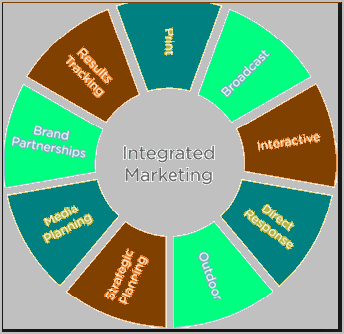
Significance of IMC
Integrated Marketing Communications is a practical tool to interact with customers and convince them to buy products of company. Each strategy Integrated Marketing Communications has great importance which can be evaluated from the results and impact of that strategy. Integrated Marketing Communications is considered as major competitive advantage in numerous firms (Kitchen and Schultz, 2001). Integrated Marketing Communications tactics can increase sales and profit while saving the time, money and stress by applying IMC (Smith, 2002). This fact is also documented by agency executives (Kitchen and Schultz, 1997). Integrated Marketing Communications has positive impact on communications, inventiveness and cause constancy in communications. Integrated Marketing Communications provides new vibrant model that assist the business to make marketing communication as consumer oriented (Kitchen, Brignell, Li and Jones, 2004). It makes easy accessibility of goods and services and makes message more efficient and reduces product related risks in the customers.
Objectives of Integrated Marketing Communications
Every policy in business has particular objectives to compete in marketplace. Integrated Marketing Communications strategy of communication is focused to accomplish specific objectives. Katrandjiev (2000) explained two contradictory objectives of IMC. First objective is to achieve substantial sales and second aim is to develop a strong brand image. Schultz (1993) stated that major purpose of Integrated Marketing Communications is to make great impact on the mind of target audience. The ultimate objective of IMC is to establish customer oriented sensibilities, assist in resource distribution, accomplish competitive advantage and develop business process in all direction of organization and its operations that enhance value for its customer. Some general objectives include creating brand awareness, favourable customer attitude and to drive business & revenue.
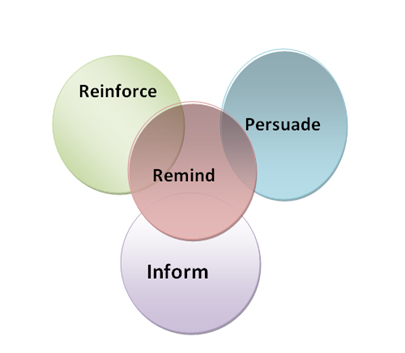
Components of IMC
In creating strategy for organization, there are different elements which support to develop that strategy. These components are support of that strategy. Such elements are essential for the successful implementations of strategy. IMC strategy has three main elements: the consumer, the channels and the evaluation of results. These components are discussed below:
- Consumers: In this factor it is interrogated how consumers get information and how the delivery of that exchange of information affects the message's form and contents.
- Communication channels: This element cross-examines several channels and how much effective each channels is in IMC strategy.
- Results: It considers how the level of complexity in IMC strategies leads marketers to calculate result by designing new methods.
Developmental Process of IMC
Integrated Marketing Communications follow different steps or stages. Mostly these steps are followed in series. Kitchen and Schultz (2000) explained the stages in the developmental process of IMC. These stages are
- Tactical co-ordination (content)
- Redefining the scope of marketing communications (channels)
- Application of information technology (stakeholders)
- Strategic and financial integration (results)
Below figure shows the major steps that organization must follow when executing Integrated Marketing Communications process:
Figure: The steps in integrated marketing process
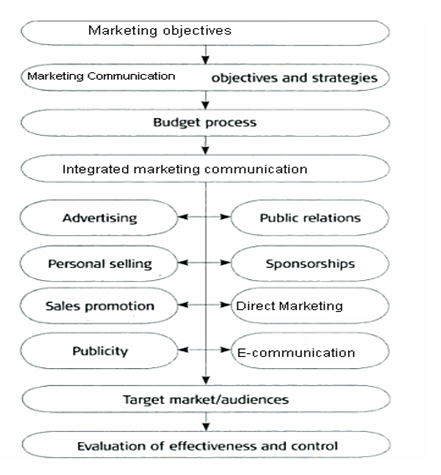
Tools of integrated marketing communications are used by marketers to make it in correct place. There are eight tools of IMC which are Advertising, Personal selling, Sales promotion, Publicity, Public relations, Sponsorship, Direct marketing and E communication. Sometimes, marketers use these tools in combinations to develop good integrating marketing communication plan for firms.
Figure: Tools of integrated marketing communications
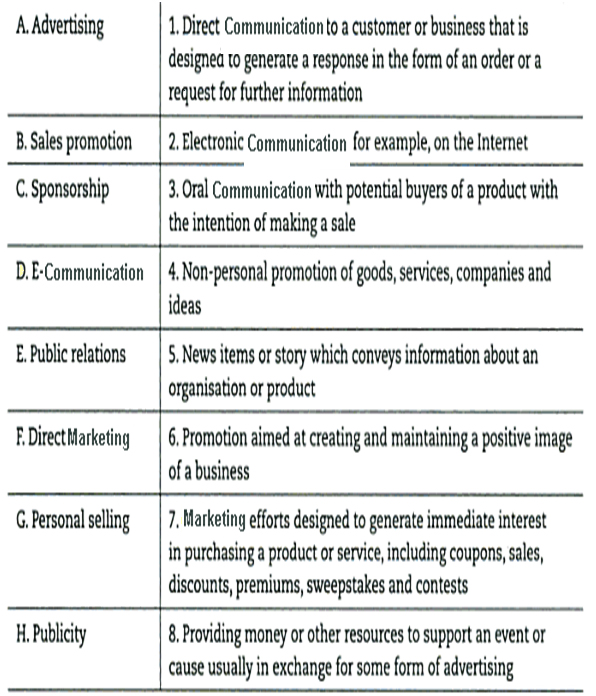
Integrated marketing communications involve all components and stakeholders from both inside and outside of organization therefore its implementation is coordinated process between each department and segment. If integrated marketing communications takes the direct line command control approach to treat other departments or segments, this type of organization structure may incur an intrinsic instability. While this virtual multiplayer approach increases the management level and increases the possibility of power conflict among top management. Refer to below figure.
Figure: Schematic diagram for IMC mechanism method and its existence flow:
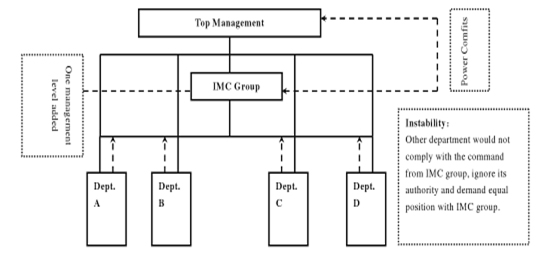
IMC differs from conventional marketing communication in numerous ways. IMC is related with some positive differences in comparison to traditional marketing communication.
Table: 1 Comparison of Integrated Marketing Communications and traditional marketing communication:
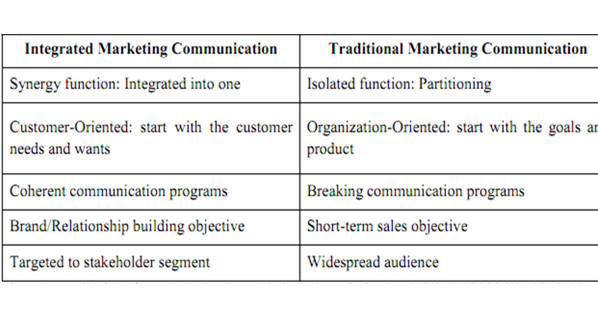
Factors Influence IMC
Many factors have great impact on the Integrated Marketing Communications. Schultz (1996) stated that Integrated Marketing Communications not only depend on incorporation of promotional mix instead it also relies on infrastructure, staffing, marketing budget and skills. Though company has competent professionals and good infrastructure but marketing budget is most important. If budget is not according to the needs of firms, it may have negative result. Kitchen et al. (2004) described that nature of business, marketing development, and required investments by business have great impact on Integrated Marketing Communications. Another theorist, Vargas (2015) said that nature of the product, nature of the market, stage in product-lifecycle, price, and funds available for the promotion also have major influence on these communication practices. It is also significant to observe that product is suffering at which stage in product-life-cycle, at each stage strategy differs. If stage is viewed incorrectly then strategy becomes ineffective and result may differ from the required result. Reid (2015) considered characteristics of the organization including type and size, as well as position in the market as influencing factors.
Barriers to the implication of IMC: Academic researches identified number of barriers to the execution of IMC. A study conducted by Eagle and Kitchen (2000), revealed that clients identified two main obstructions. Firstly, employees was not equipped and needed to develop new skills and expertise to work in this integrated manner. Secondly, existing organisational structures made integration difficult.
To sum up, Integrated Marketing Communications is widespread in organizational set up at global level. IMC is the effectual process to develop and execute various forms of influential communications programs with customers and prospects over time. The target of IMC is to influence or directly affect the behaviour of the particular communications audience. IMC considers all sources of brand or company contacts which a customer or prospect has with the product or service as potential delivery channels for future messages. IMC gives positive impact with triumphant promotional integration if it is realized with appropriate process. Integrated Marketing Communications has good effect as brand equity, brand awareness, profitability and changing attitude of consumer. Theoretical studies indicated that Integrated Marketing Communications makes use of different marketing communication elements to transmit the same message. Many researchers found that Integrated Marketing Communications increases customer's awareness about particular product. Many organizations use this communication tool to build healthy relations with customers and in turn enhance sales. It is essential to manage all components of Integrated Marketing Communications to become successful in competitive market.

